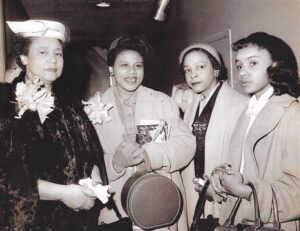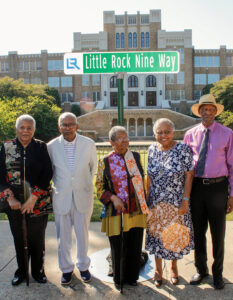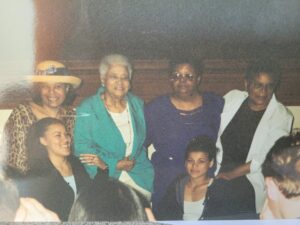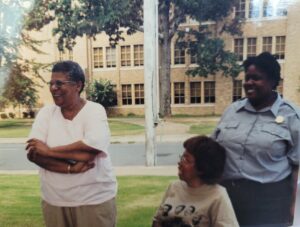calsfoundation@cals.org
Children of History
Moments in history sometimes stand out because of the audaciousness of the action. Looking beyond the moment to examine the root reveals fascinating facts, placing that moment in a new context.

One such moment is the Central High Desegregation Crisis that was spotlighted around the world in 1957–58. The pioneering Black teens were highlighted in news programming as they attempted to attend the supposedly desegregated Little Rock Central High. Before transferring to Central, the teens attended segregated schools for Black students. Carlotta Walls, Jefferson Thomas, and Gloria Ray attended Paul Laurence Dunbar Junior High School, while Ernest Green, Elizabeth Eckford, Thelma Mothershed, Terrence Roberts, Minnijean Brown, and Melba Pattillo attended Horace Mann High School.
One student in particular received prolonged attention throughout the school year. Minnijean Brown (later Minnijean Brown Trickey) is a stand-alone name in the history books. Along with the rest of the group of Black students dubbed the Little Rock Nine, she began attending Central High under escort by U.S. Army troops as ordered by President Dwight D. Eisenhower.

Minnijean Brown was expelled from the school in February 1958 after reacting to a student who was tormenting her in the cafeteria. She was offered a scholarship to finish her high school career at the New Lincoln High School, a private progressive school in Manhattan, by Dr. John L. Brooks, founding director of the school. During her time in New York, she stayed with Drs. Kenneth B. and Mamie Clark, African American psychologists whose social science research formed the basis for the National Association for the Advancement of Colored People (NAACP) argument in the Brown v. Board of Education of Topeka, Kansas case, which held that segregation harmed the self-esteem of Black children. Brown graduated from the New Lincoln School in 1959.
Minnijean Brown’s story and those of the other members of the Little Rock Nine are well documented in the history of the state and nation.
Minnijean Brown Trickey is a sister of Willie Bobby Brown, who was president of Black United Youth, a local group described as an “eyeball to eyeball” organization designed to raise consciousness for the city and state about concerns in the Black community. A primary concern for the organization was economic power.
Around 1968, the group formed and pushed for more representation, as twenty-five percent of the population of Little Rock was Black but that percentage was not represented in most areas of employment. Bobby Brown, in a 1993 interview with historian John Kirk, spoke about how Black folks would buy cars without ever seeing the inside of the showroom. They would bank without ever seeing a Black banker. They would not see more than one Black person working in a grocery store and none on the management level. The Black United Youth chapter in Little Rock was successful in pushing “first hires” in areas of employment that systemically resisted or limited hiring of Black people, including local government, public service, and social programs. The impact of the group is gauged by the fact that it was targeted by the Federal Bureau of Investigation. Brown died on May 12, 2001, but his influence still lingers today.

Minnijean (sometimes spelled Minnie Jean) and Bobby are the first daughter and son of Imogene Brooks Brown. Imogene was a 1935 graduate of Little Rock’s Dunbar High School and also attended Dunbar Junior College. She was the first Black nurse hired at Arkansas Children’s Hospital in Little Rock on a permanent basis. She was a member of Union AME Church, where she worshiped for eighty years. Imogene was born in Morrilton, Arkansas, to Ernest Brooks and Minnie Gill Brooks. Minnie’s father was born in Maryland. Minnie was born in Arkansas, but her mother, Mariah Barnett Gill, was born in Richmond, Virginia.
The 1930 U.S. Census shows Ernest and Minnie owning their home, valued at $1,500. Minnie’s brother, Forrest William Brooks, served in the military during World War I. The 1930 U.S. Census shows Forrest living in Little Rock, with his home owned and valued at $2,200. Ernest’s parents, William and Luella Dowdle Brooks, were both born in Baltimore, Maryland.

The names of their ancestors may not be as prominent in history as those of Minnie Jean and Willie Bobby, but they are also part of the history of America by rights and by location of their births. The lessons they learned were shared generationally and prepared Minnie Jean and Willie Bobby to stand up and stand out when it was their time to take leadership roles in their community.
By Rhonda Stewart, genealogy and local history specialist for the Central Arkansas Library System’s Butler Center for Arkansas Studies, housed in the CALS Bobby L. Roberts Library of Arkansas History & Art




